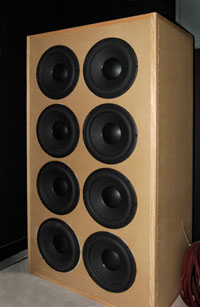I chose a sealed box enclosure because it is easier to build a speaker that sounds good. Vented enclosures are more efficient and can be designed with deeper bass response without equalization, but the enclosure must be carefully tuned to the exact driver parameters. A mistuned enclosure can cause significant frequency response anomalies. With a sealed enclosure, the larger the box, the lower the Q factor. I chose a Q factor of 0.5 which results in slightly overdamped "very tight" bass. The free air resonance of the Peerless XLS subwoofer is fairly high, so even with a low Q design, the system will start to roll off at a frequency far higher than is desirable for a home theater subwoofer. Therefore, some form of equalization is required to provide flat response to below 20Hz. I am using my Rane PE-17 parametric equalizer to adjust the frequency response in my room. Below the system resonance frequency (a little above 40Hz for my enclosure), the cone excursion requirements increase significantly. I decided to use eight drivers in order to provide adequate power output at 20Hz without bottoming out the speakers. The enclosure is built using 1" MDF board with internal 2x2 and 2x4 bracing. The front baffle is built using 2 laminated 1" boards (for a total thickness of 2") since the driver cutouts reduce the structural integrity of the baffle. All corners are braced with 2x2s and numerous 2x2 and 2x4 braces are used front-to-back, side-to-side, and top-to-bottom to reduce any flexing of the enclosure panels. The external dimensions of the enclosure are 58" H x 32" W x 20" D. I haven't bothered to weigh the finished unit, but I would estimate that it weighs in excess of 250 lbs. The drivers themselves are bolted to the front baffle with stainless bolts that go all the way through the baffle. Caulking is used around the speakers and inside all joints. The MDF board is glued and screwed to all internal bracing. The drivers are wired in parallel and series to two separate connections, providing a nominal 8 ohm load to each connection. A separate bridged Bryston 4B-ST amp is used for each of these connections, providing a total of 1600 watts of amplification. With equalization, the room response is flat within a few db from 18Hz through the 75Hz crossover frequency. I have not heard any clipping or bottoming out on any of the movies I've watched. Even with all the noise isolation I used in the construction of the theater, this subwoofer is capable of rattling the glasses in the kitchen cabinets on some effects passages.
|
